
 |
|
|
#1 |
|
All the news that's fit to excerpt
Name: newsie
Location: who knows?
Join Date: Jun 2008 Motorcycle(s): only digital replicas Posts: Too much.
|
[cycleworld.com] - 2024 Yamaha Tracer 9 GT+ First Ride
Yamaha’s Tracer 9 GT+ is the brand’s latest spin on finding the perfect sport-touring recipe. Lots of tech plus the CP3 triple equate to balanced performance.
Click here to view on their site. 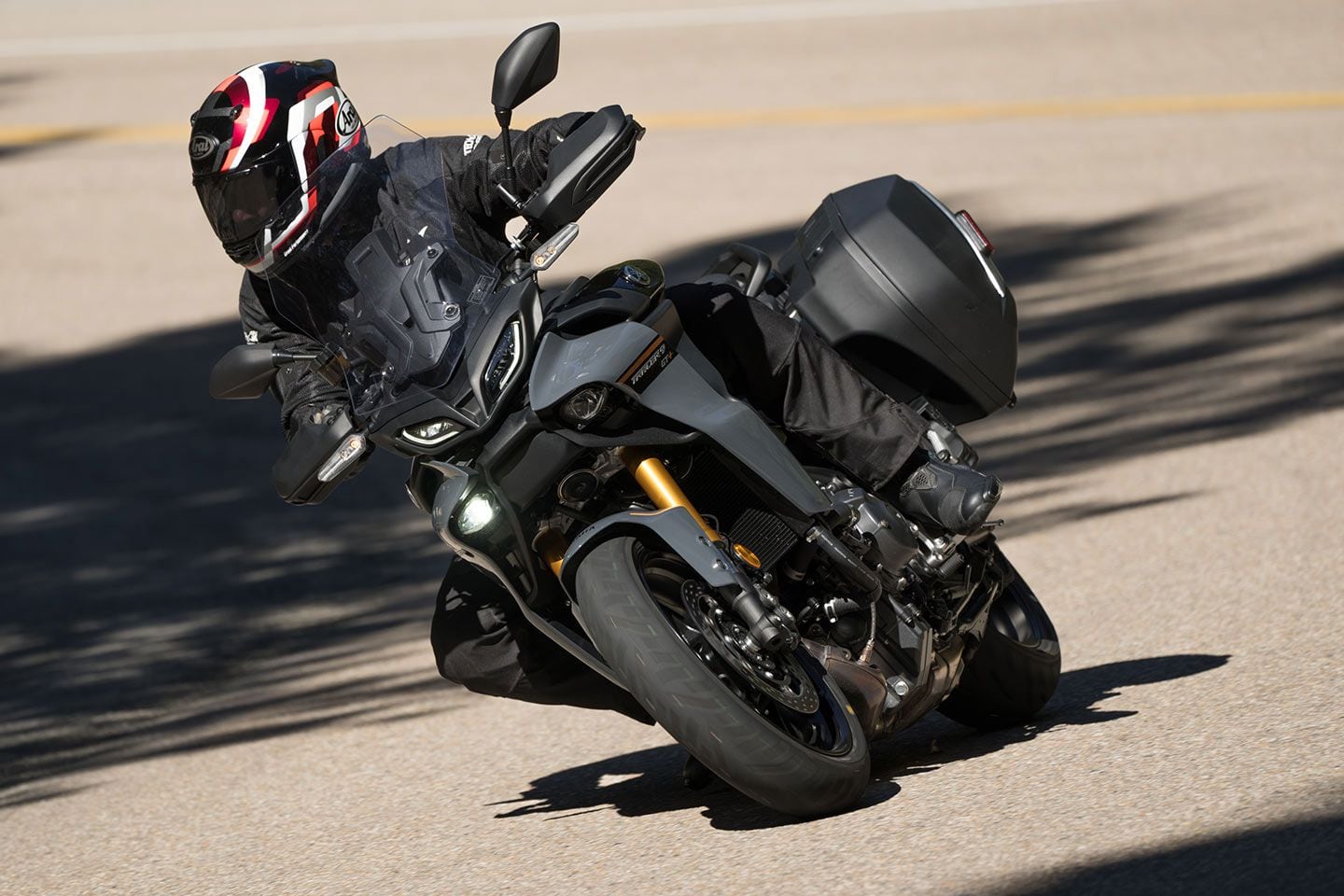 Yamaha’s 2024 Tracer 9 GT+. (Joseph Agustin/)The definition of a sport-touring bike has always been a moving target. We may never know if the original intent was to build a sportbike with better touring capabilities, or a touring bike with more sporting intentions. At Cycle World, we first acknowledged sport-touring in our Ten Best categories back in 1999, and that overlap between classes has generated a ton of great motorcycles over the years. But like everything in motorcycling, the goal posts have moved as sport-touring has become ever more specialized. For years there were traditional models like Yamaha’s own FJR1300ES, but now you could argue that street-biased adventure-tourers like the Super Ténéré ES fill a similar role. Add to this a new breed like the Tracer 9 GT+ (an evolution of the Tracer 9 GT) that continues to prove that less with more can be better. 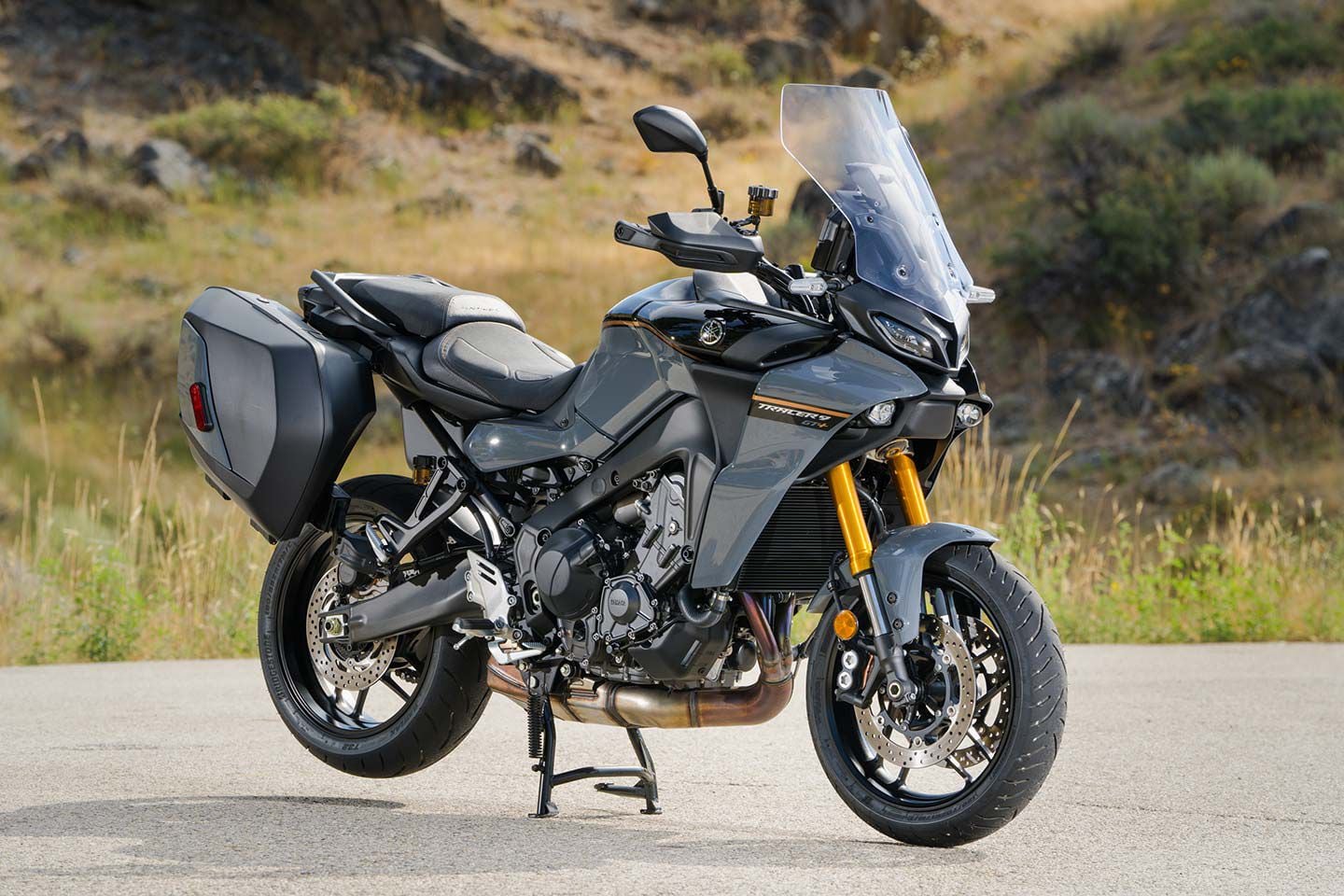 Yamaha’s 2024 Tracer 9 GT+ is packed with high-tech features not offered in the price range normally. (Joseph Agustin/)Less weight compared to open-class models plus more technology and better balanced performance were clearly the goals for the new 9 GT+. There is no question that Yamaha achieved the first two, on paper at least. The GT+ weighs a whopping 150 pounds less than the FJR1300ES, and comes packed with a comprehensive suite of electronics, including an industry-first use of Radar-linked Unified Braking System. As for the goal of achieving better balanced performance, we’re here to find out, spending a day riding the bike in the mountains around Boise, Idaho. Here’s a quick rundown of some of the standout new features that put the plus in GT+. One of the most significant additions is the Adaptive Cruise Control that utilizes front-facing millimeter wave radar to actively maintain a preset distance to the vehicle in front of you. Also utilizing the radar is the industry-first Radar-linked Unified Brake System that can help aid the rider in certain braking situations by optimizing braking force and or bias front to rear. More obvious from the saddle is the new 7-inch full-color TFT display and new control pods for navigation of menus. The KYB electronic suspension has been updated to work in unison with the radar/cruise features, while a more sophisticated quickshifter rounds out major updates. Engine The Tracer 9 GT+’s engine is a liquid-cooled 890cc inline-triple with twin overhead cams and four valves per cylinder. Bore and stroke measure 78 x 62.1mm with forged aluminum pistons sliding in direct-plated ceramic-composite cylinder bores. The compression ratio is 11.5:1. The last time we had a Tracer 9 GT on the Cycle World dyno it produced a healthy 104.2 hp at 9,900 rpm and 62.2 lb.-ft. of peak torque at 6,990 rpm at the rear wheel. The throttle bodies are managed by Yamaha’s Chip Controlled Throttle (YCC-T) that also incorporates the Accelerator Position Sensor Grip (ASPG) ride-by-wire system. The triple’s intake ducts have different lengths which not only help efficiency, but give the CP3 engine a unique sound. 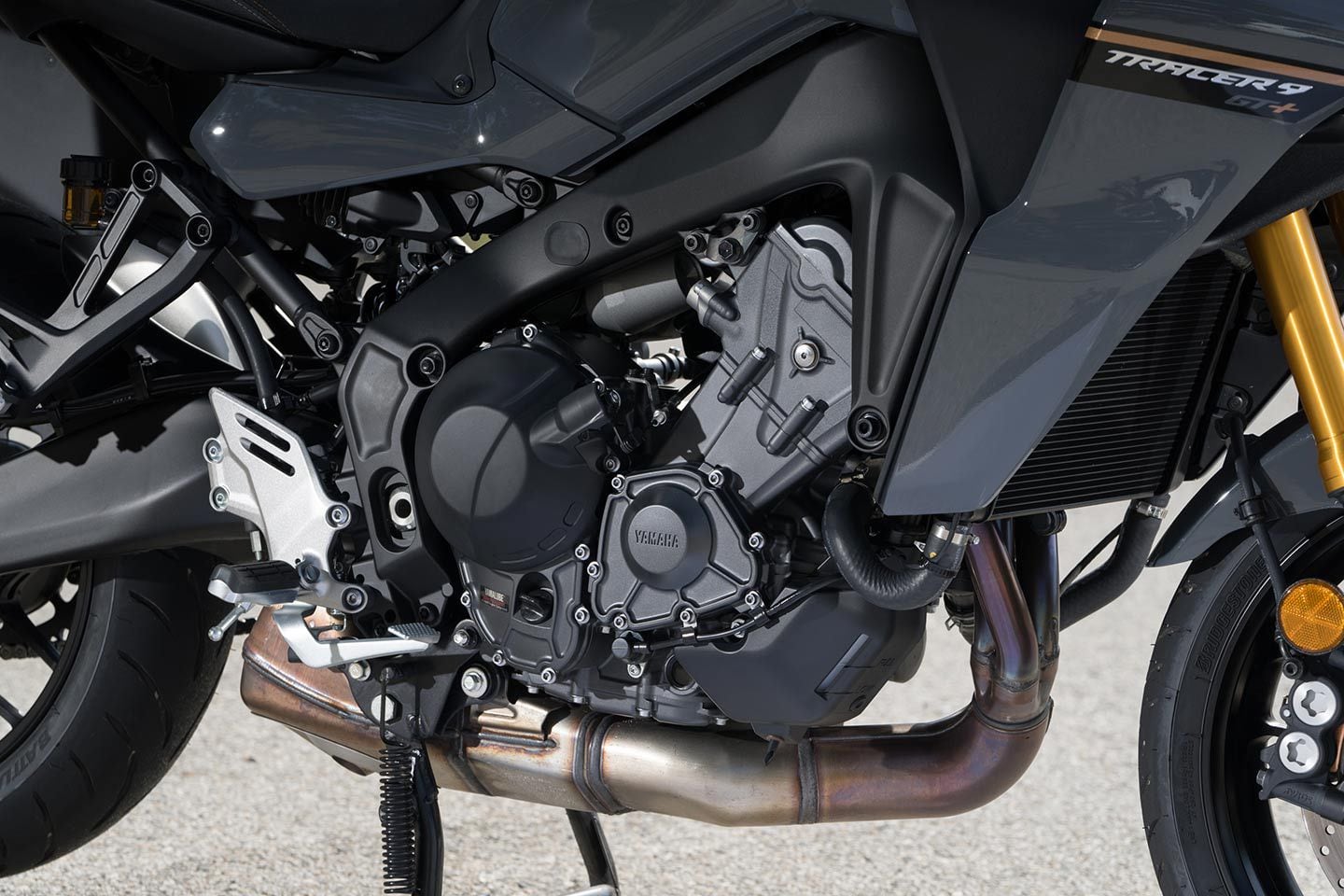 Yamaha’s CP3 inline-triple offers balanced performance for the Tracer 9 GT+. (Joseph Agustin/)Power is routed through an assist and slipper clutch that offers a light pull at the lever and then also provides slipper functionality. The six-speed transmission sends power to a chain final drive, which helps keep weight to a minimum at the expense of a little bit more maintenance compared to the FJR’s shaft final drive. Traditionalists will argue that a sub-900cc sport-tourer just doesn’t have the oomph for the task at hand, but we beg to differ. The Tracer 9 GT+ is definitely leaning more toward the sporty side of the spectrum and the very nature of the triple delivers a flat torque curve and linear power delivery across the rev range. Weighing less than 500 pounds with a full tank of gas, the GT+ promises to deliver good performance. Electronics Yamaha’s Tracer 9 GT+ is a tech junkie’s dream. This bike is packed with a suite of electronics that rivals anything that European brands like BMW, Ducati, Triumph, and KTM, have set the standard with. 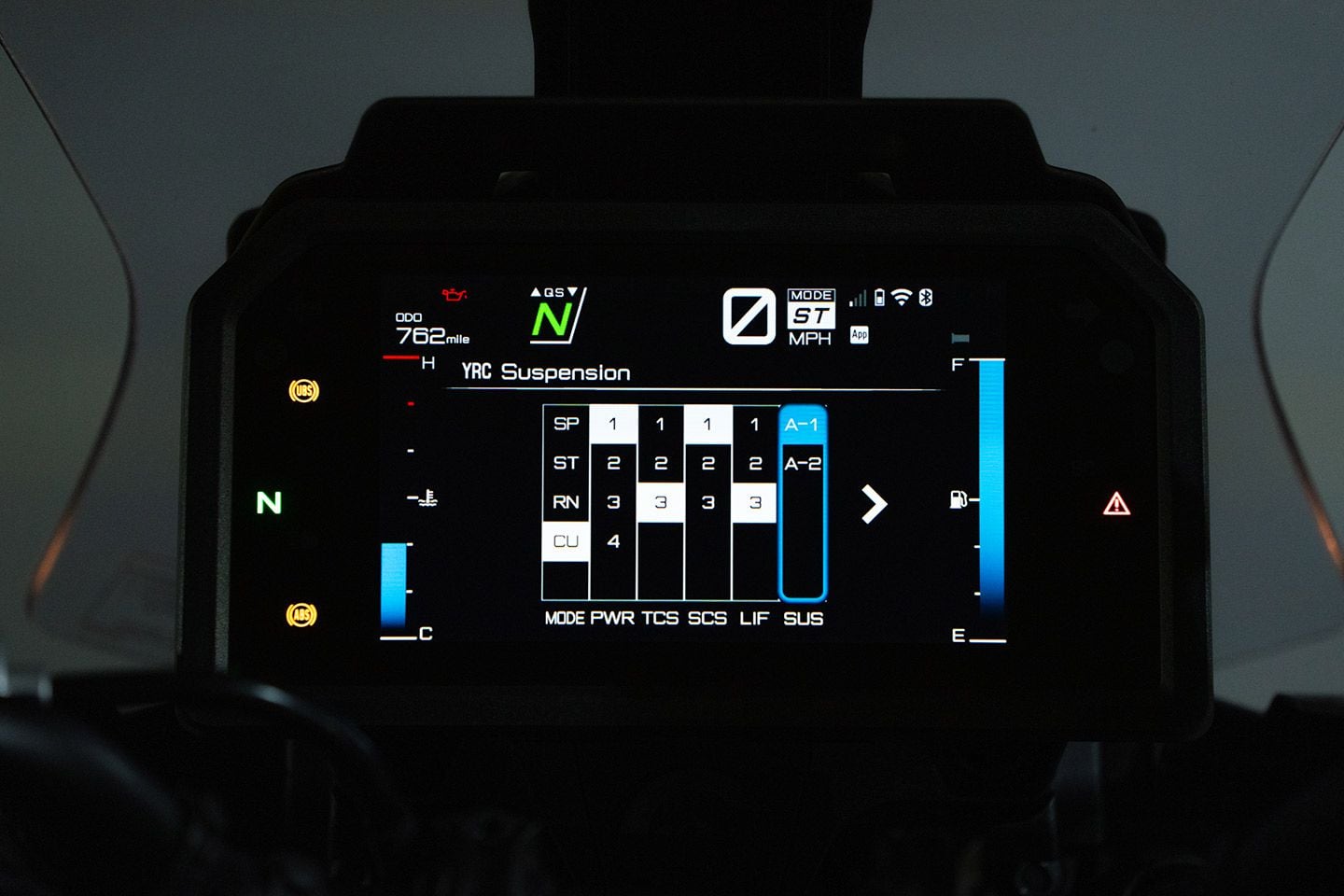 The GT+’s modes and rider aids are easy to alter with the new interface. (Joseph Agustin/)Starting with the traditional rider aids, at the core is a six-axis IMU that gives the GT+ the ability to provide lean-sensitive intervention for many features. These aids have preset levels associated with the three ride modes: Sport, Street, and Rain. A fourth Custom mode allows the user to set up the parameters to preference. Inside of those Integrated Ride Modes are four settings for Power, three traction-control choices, three slide control (SCS) settings, three wheelie-control (LIF) options, in addition to Off, and two semi-active suspension choices (addressed further below). The new third-gen quickshifter can also be set to only help with upshifts, only downshifts, both, or shut off completely. 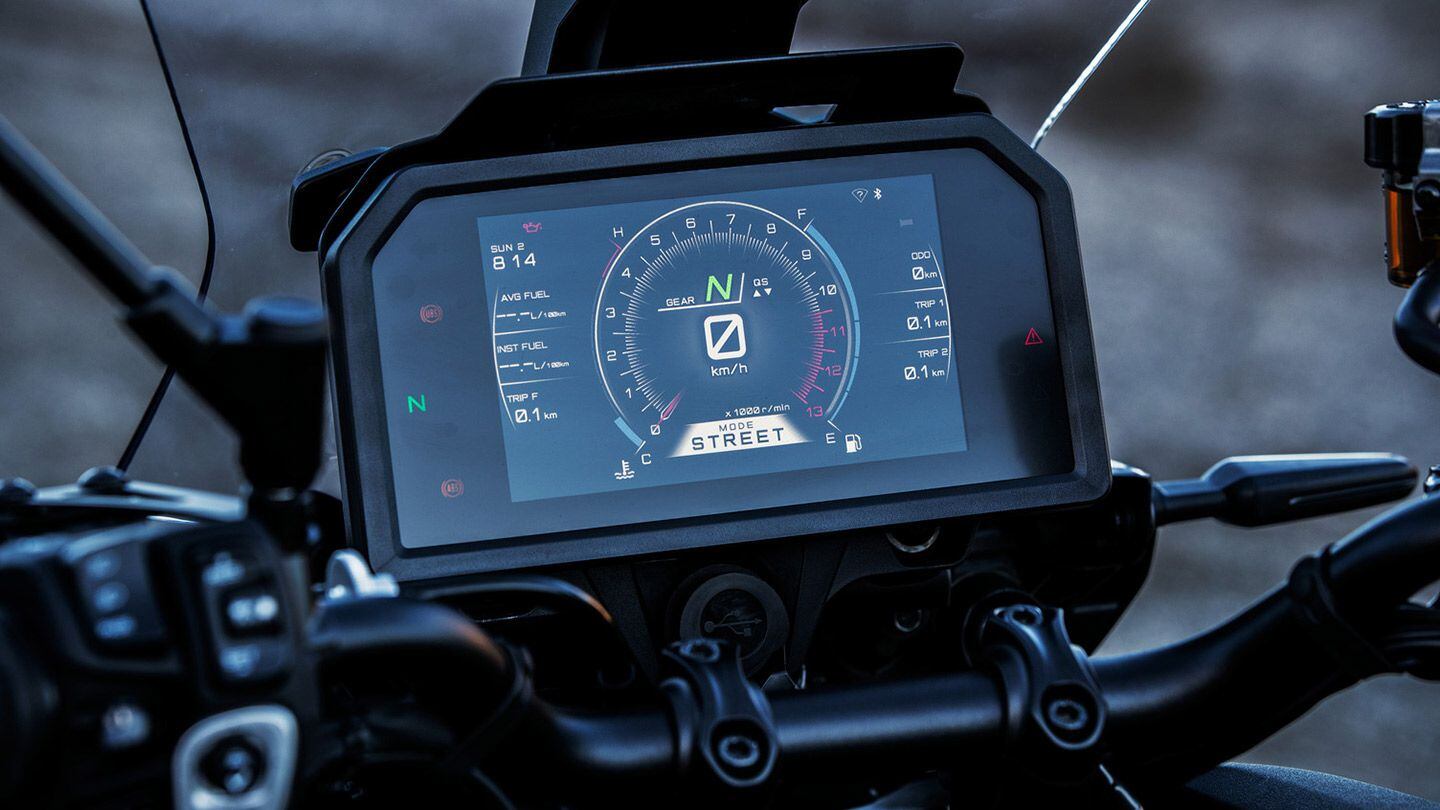 The brand-new 7-inch TFT display offers abundant info, and offers multiple view options. (Joseph Agustin/)Gone are the former twin info screens of the previous model, which are replaced by a beautiful 7-inch full-color TFT display. This screen blows away anything offered on any other current Yamaha. Not only is it bright and easy to read (helped in part by an anti-glare coating) but it has options for three display styles. From a functionality standpoint, the new handlebar control pods make menu navigation much better than the click wheel of old, which has been replaced with a joystick similar to the one on the new Ducati Multistrada that we’ve raved about. 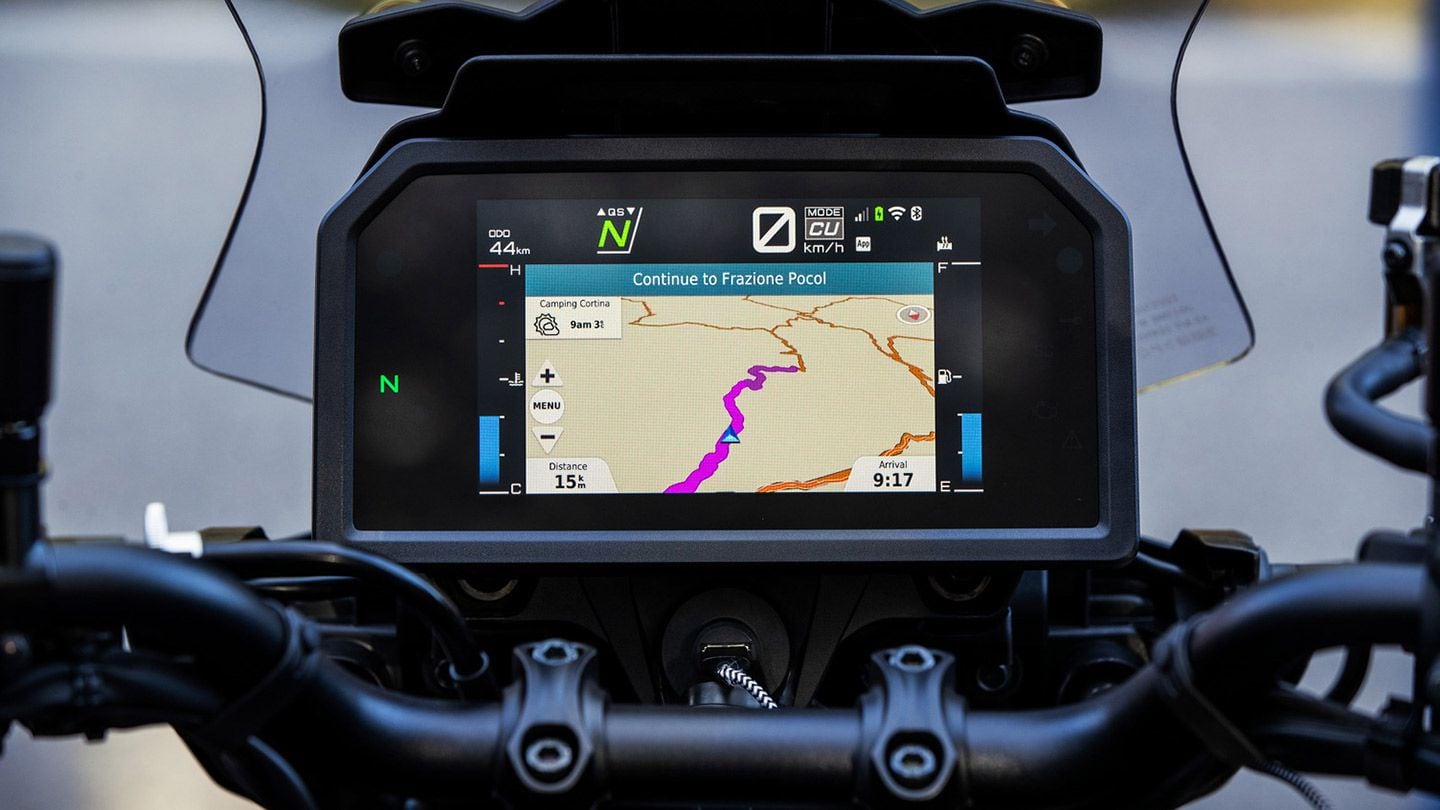 Bluetooth connectivity allows users to tether smartphones to the dash for music, calls, texts. While Garmin’s Motorize app provides on-screen navigation. (Joseph Agustin/)You can now connect your smartphone via Bluetooth without having to use a third-party app, which allows you to connect a helmet communication system and control music, as well as place and receive calls. For those who want a bit more the Yamaha MyRide app can be downloaded, which also allows you to utilize the Garmin Motorize app for on-screen navigation functionality. Two major new electronic features are associated with the millimeter-wave radar unit mounted under the headlights. Adaptive Cruise Control is the most significant of the pair, allowing modern automotive-style control to the Tracer 9 GT+. The system allows the rider to set desired speed between 20 and 99 mph in any gear. And the new quickshifter won’t interrupt the cruise control, allowing you to shift while it’s set without disengagement. Following gap has four settings, which the bike maintains via information from the radar unit, then uses engine-braking (first), and brake application (second) to maintain the gap. Like similar systems, if you’re approaching a vehicle ahead, the bike will slow to maintain the set distance, then when you pull out to pass it will utilize all of the electronic systems (lean angle, suspension) to smoothly accelerate back up to your set speed. In order for cruise to be activated TCS, SCS, and LIF must be on. 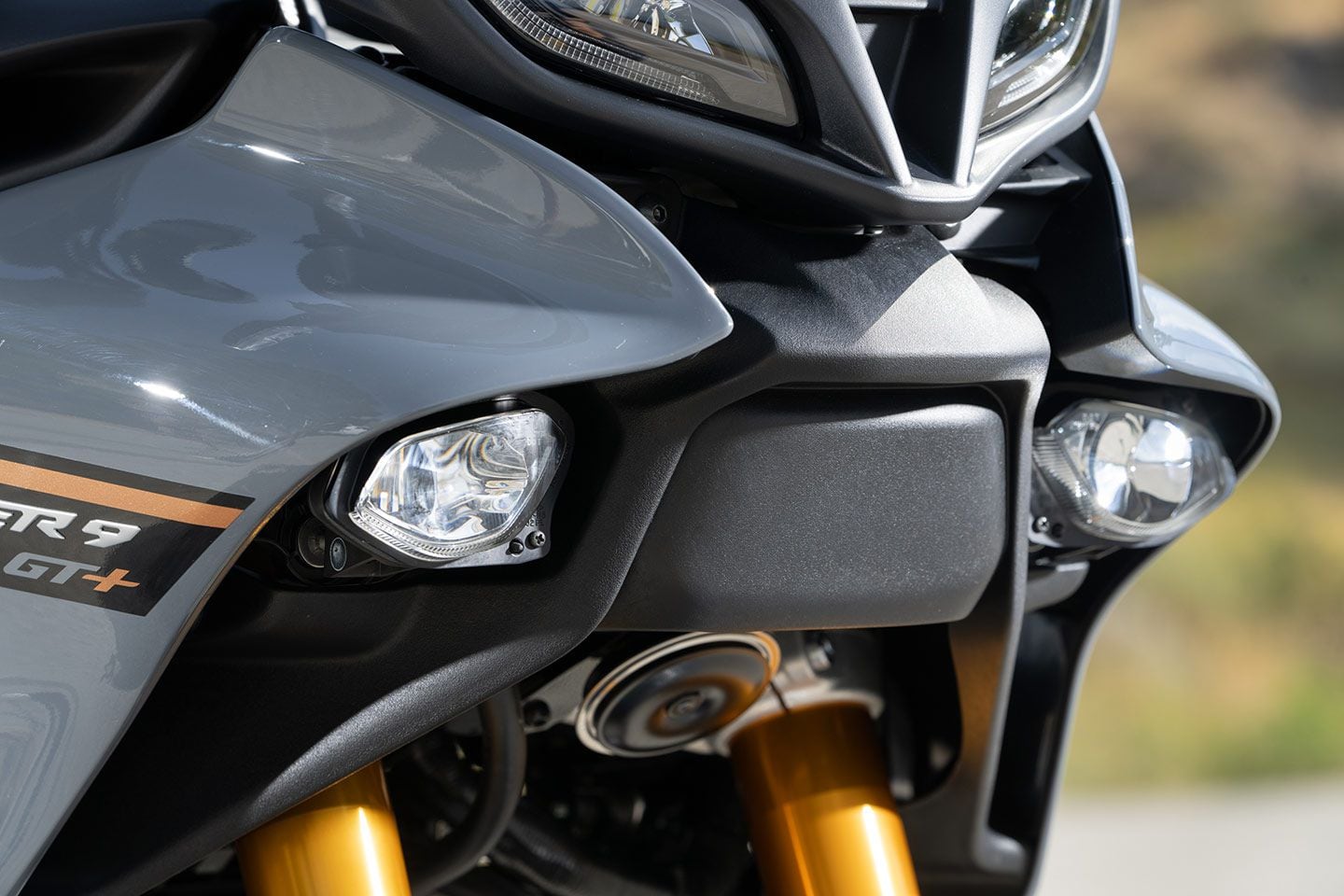 In between the cornering beam lights resides the millimeter wave radar unit. (Joseph Agustin/)Yamaha says that its new Radar-linked Unified Braking System is an industry first. In short, it’s a system that can help the bike achieve more efficient and safe braking in certain situations. Yamaha is quick to point out that it isn’t a collision-avoidance system; what it’s designed to do is to aid the rider when braking if the radar detects an object in the bike’s path. If the system is on and the rider is already actively braking and it picks up an object/vehicle in the road, it can aid the rider by applying additional braking pressure to either the front, rear, or both brakes to help the bike stop as quickly as possible. The six-axis IMU knows the bike’s lean angle so it can manage the ABS accordingly. Additionally, it can add compression damping to the front suspension to keep the fork from diving excessively. The goal is to allow the bike to brake with maximum efficiency even if the rider’s inputs aren’t optimal. New LED cornering lights will be appreciated by all. When the IMU detects a lean angle greater than seven degrees, the lights automatically illuminate the inside of the corner, regardless of whether high or low beam is selected. Chassis The anchor for all things chassis is the control-filled aluminum-diecast frame and aluminum swingarm. The lightweight chassis helps keep the Tracer 9 GT+ under 500 pounds at a claimed 492 (up from 485) with a full tank of fuel. Wheelbase spans 59.1 inches (which for reference is about 1-3/4 inches shorter than the FJR1300ES), while rake and trail measure 25 degrees and 4.3 inches, the former of which is a full degree steeper than the FJR. Yes, we are comparing apples to oranges, but it’s interesting to note the contrast between the OG Yamaha sport-tourer and the newest kid in the corral. Geometry numbers are informative, but it’s really the GT+’s suspension that defines how the chassis performs. Like the previous model, this generation has KYB electronically controlled KADS suspension (KYB Actimatic Damper System). The key difference here is that the suspension is not only tethered to the six-axis IMU, but then linked to the two new radar features, the Adaptive Cruise Control and Unified Braking System, to allow the aforementioned damping adjustments; this required new algorithms for the software. 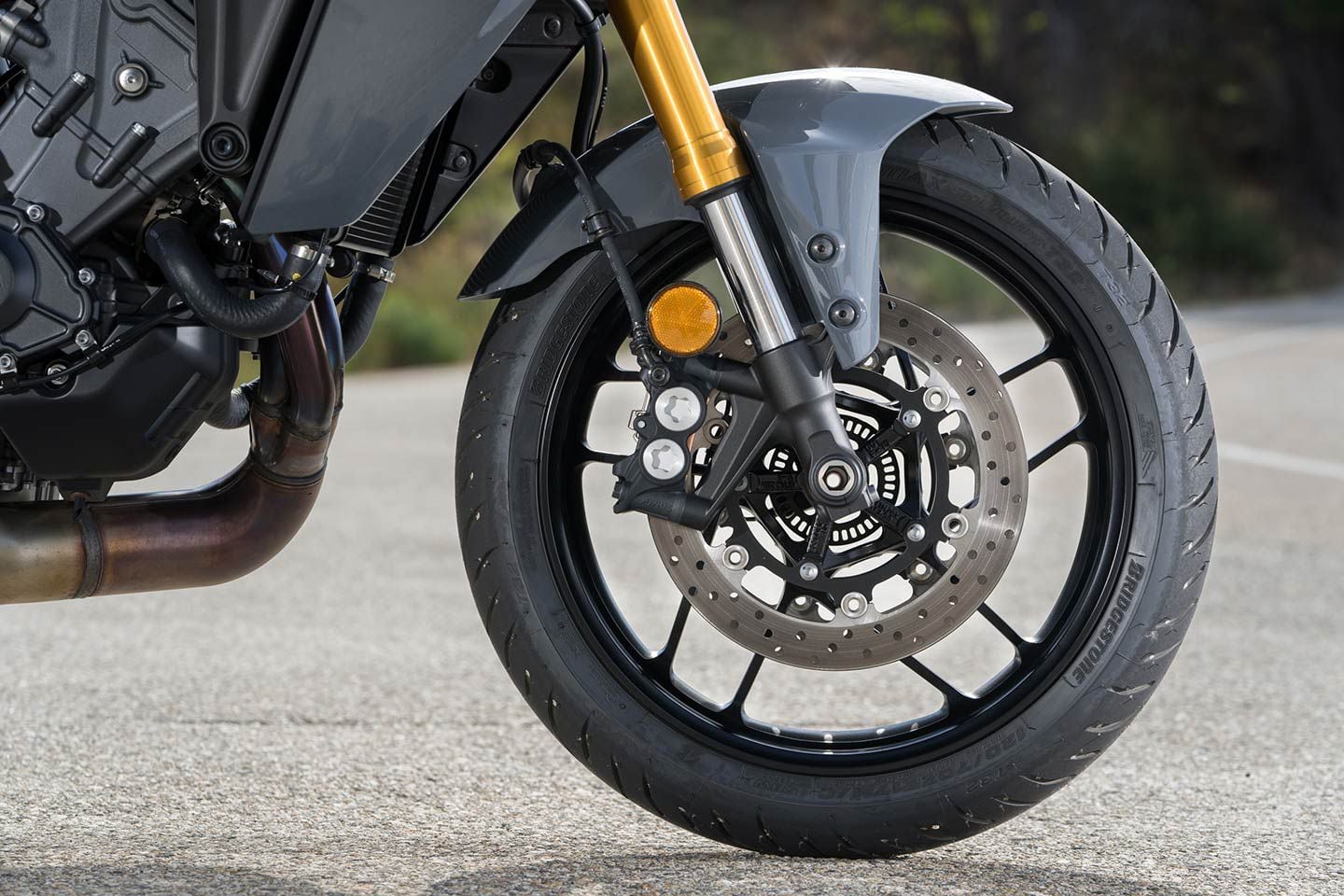 KYB semi-active suspension is also connected to the two new radar features to keep the front end from diving under braking when the cruise control or the Unified Brake System intervene. (Joseph Agustin/)There are two suspension-damping modes on the GT+; A-1 is the sportiest setting and A-2 is the comfort setting. Unlike other models like the MT-10 SP where damping settings can be manually altered, these are locked. However there are clickers for preload adjustment on the fork and there is an easy-to-access remote preload adjuster for the shock to help you compensate for extra loads such as a passenger and/or full luggage. 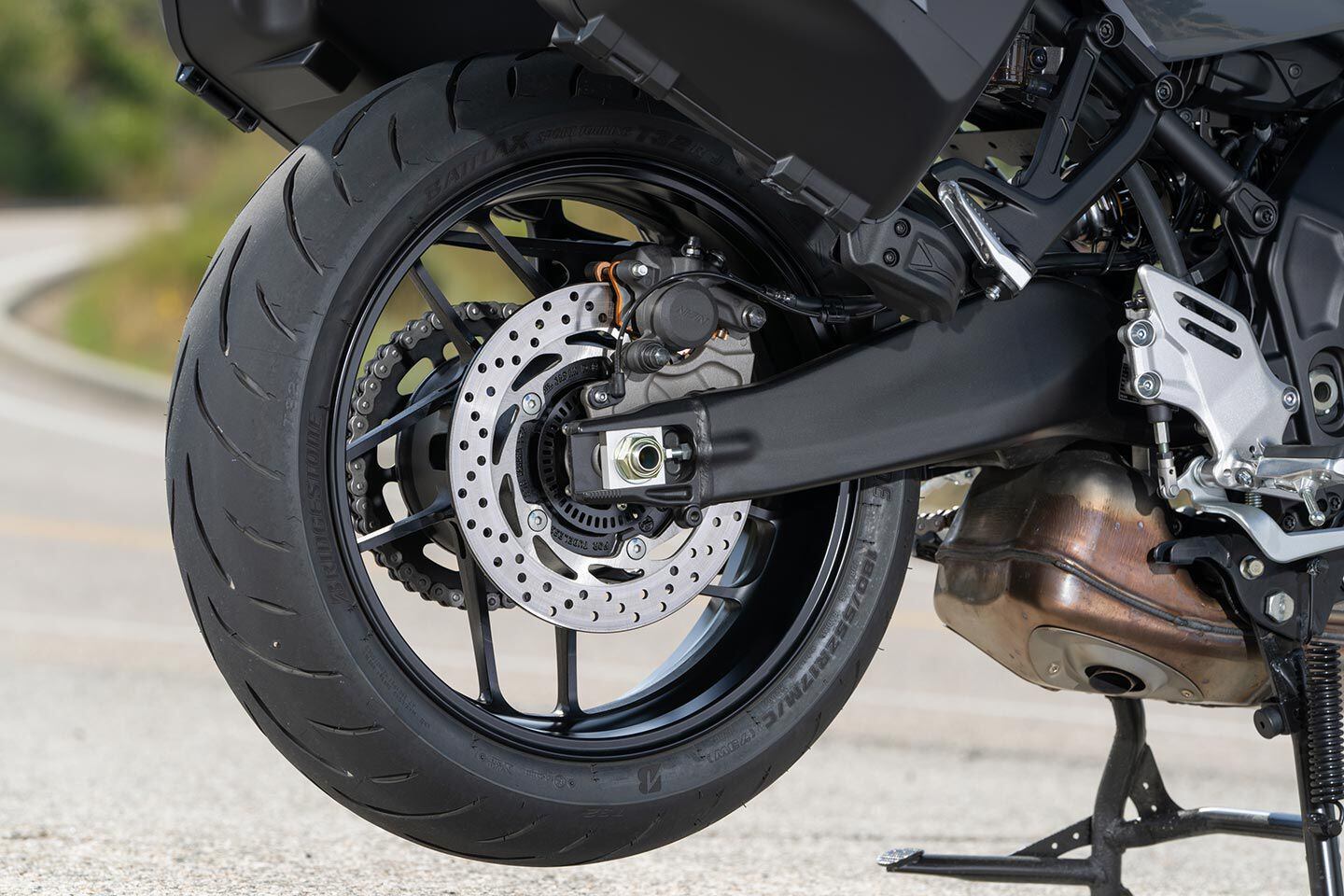 A larger 267mm rear disc is used because the Unified Brake System will likely depend on the rear brake more than most users would on their own. (Joseph Agustin/)We’ve already covered the electronic aspects of the Unified Braking System, but the hardware consists of a pair of four-piston radial-mount calipers up front, pinching a pair of 298mm discs and fed by a Nissin radial master cylinder. Out back is a 267mm disc (up from 245) that was increased in diameter because the Unified Braking System will likely use the rear brake more frequently than the user might do on their own. Lightweight Spin-Forged Aluminum wheels are mounted with Bridgestone Battlax Sport Touring T32 tires in 120/70-17 front and 180/55-17 rear sizes. Ergonomics/Touring Features Comfort is a high priority on any sport-touring model, so Yamaha made sure that the Tracer 9 GT+ could accommodate a wide variety of riders. The revised seat has a new shape with softer foam and can be adjusted to two standard positions (32.3 or 32.9 inches). Furthermore, the footpegs can be adjusted to two different heights (the secondary position is 14mm higher and 4mm back), while the handlebar can be moved 9mm forward and 4mm higher in its secondary position. The touring windscreen is adjustable with an easy-to-reach lever above the instrument stack that can be done on the fly. 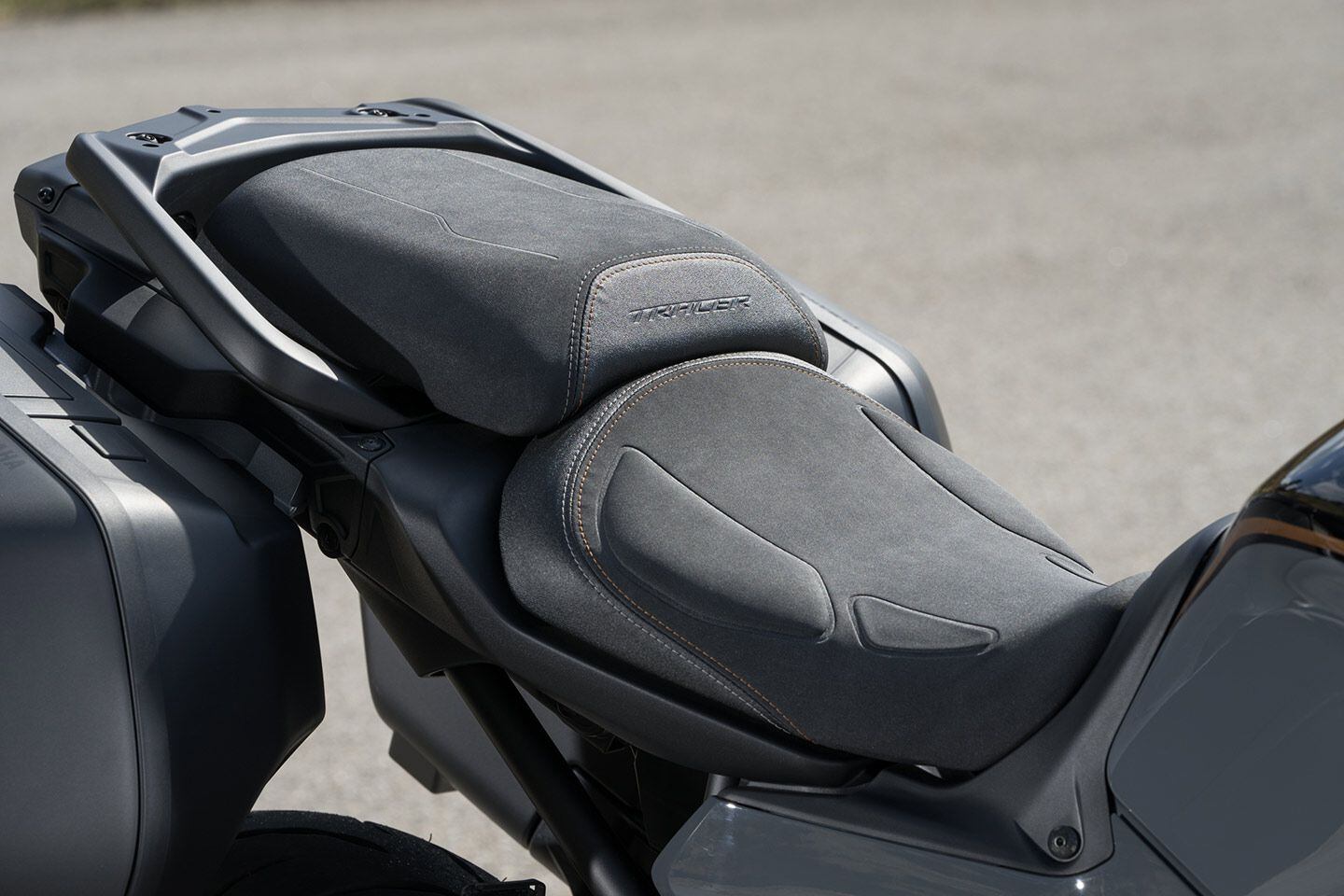 The newly shaped seat has two heights, 32.3 and 32.9 inches. A heated unit is available as an accessory. (Joseph Agustin/)Creature comforts include standard 10-stage adjustable heated grips while a heated seat is offered as an accessory. Other features included are a centerstand and the included rubber-damped, lockable side cases that offer 30 liters of storage each. An optional top case is available. 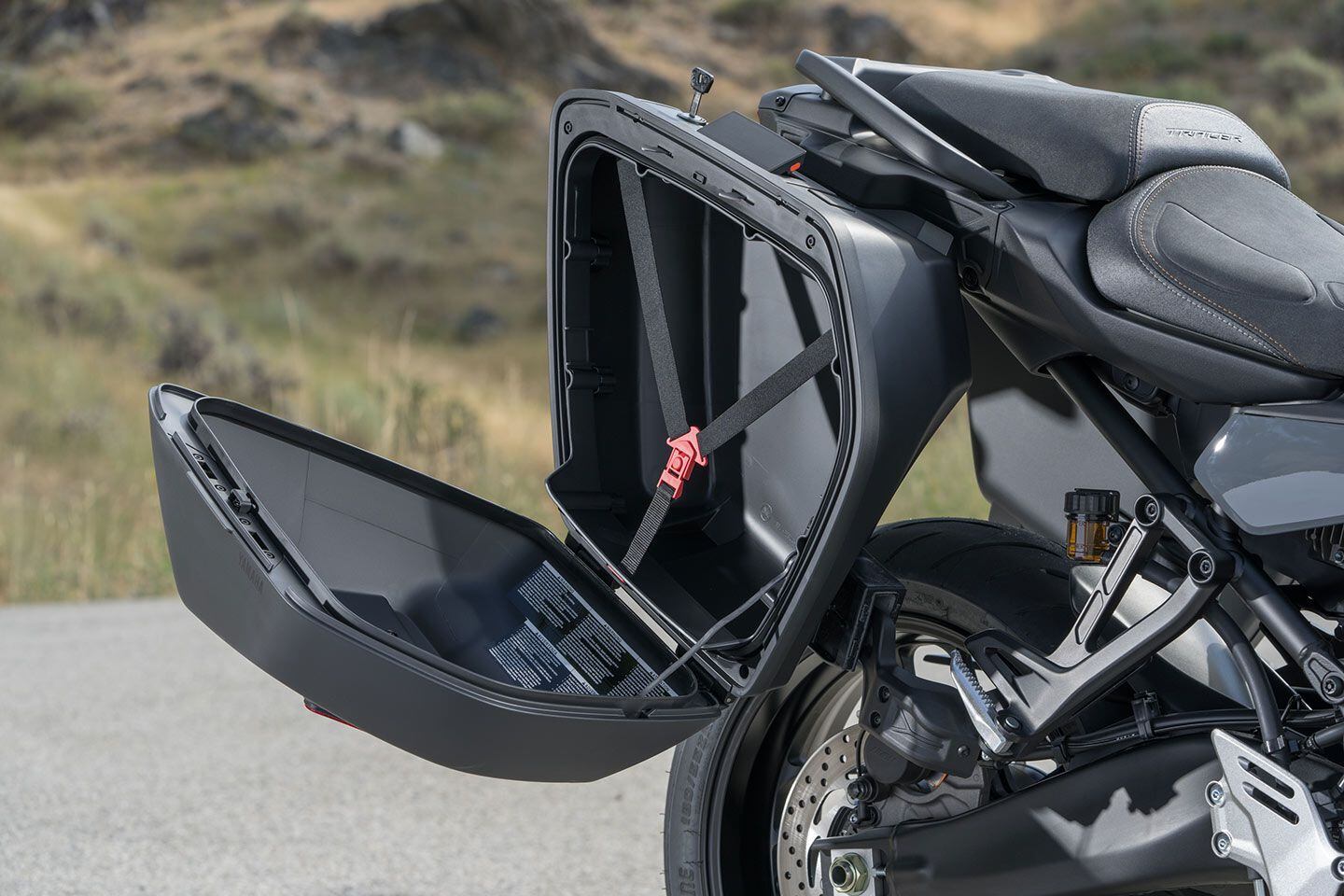 The 30-liter-capacity side cases have rubber dampers to keep bag contents from getting scrambled. (Joseph Agustin/)Riding Impression Our day testing the bike in Idaho included everything from big sweeping curves along the Payette River to the tight mountain roads heading up to Bogus Basin ski area, plus a variety of highway and urban riding. 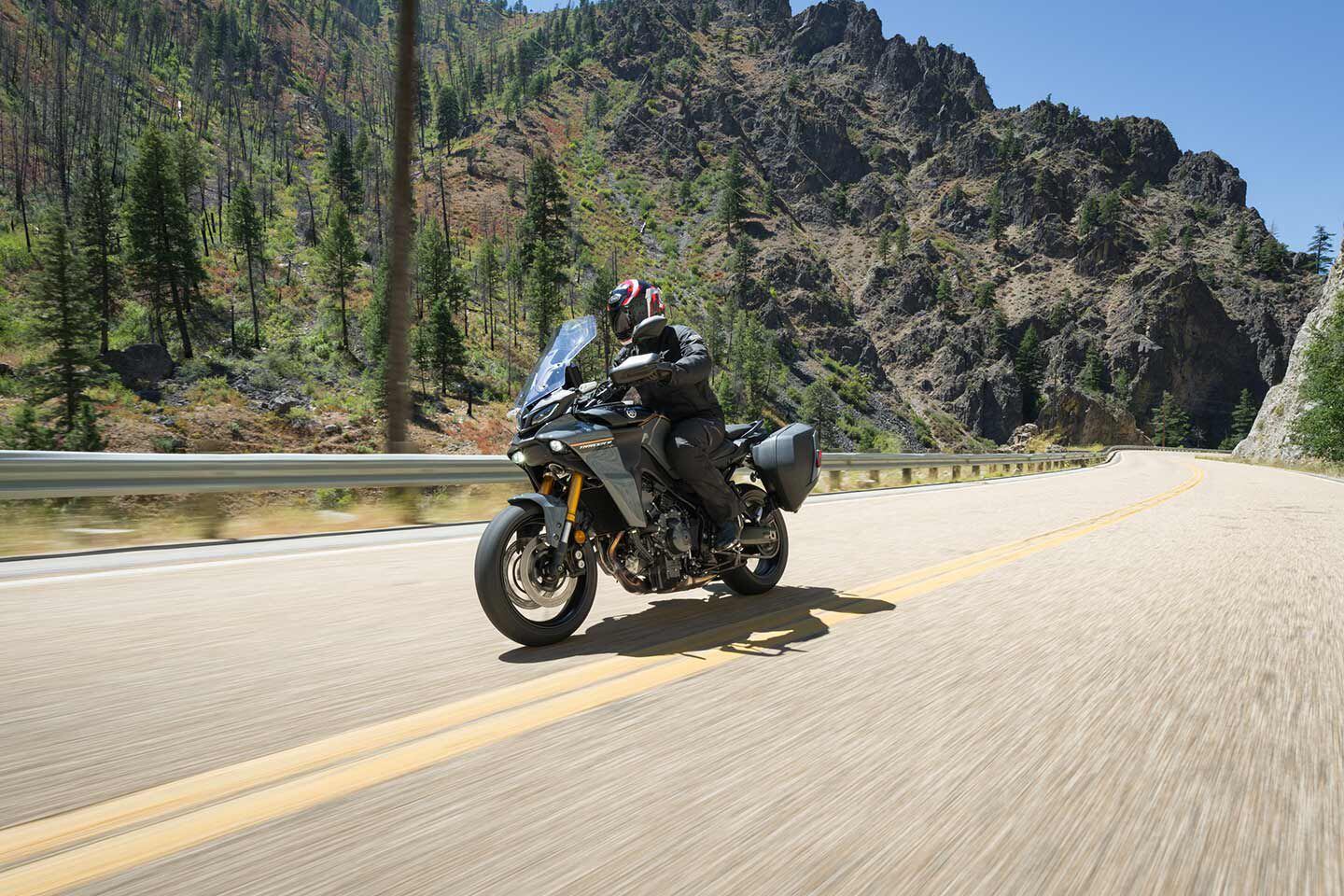 The fast sweepers along the Payette River near Boise, Idaho, were a blast on the GT+. (Joseph Agustin/)Rolling out of town for the mountains is one situation where the engine proves how versatile it is. In an urban setting, the low-end torque and smooth delivery make negotiating stop-and-go traffic no big deal. Easy getaways from stoplights are aided by a crisp clutch, while the updated quickshifter has been improved to better handle shifts while on the throttle or while decelerating. Response and shift-lever action are really good, with less notchiness than some other systems we’ve recently tried. It has good timing regardless of engine rpm. Heading up the twisties to Bogus Basin is where the triple really shines. Ample bottom-to-midrange torque allows you to choose between a couple of gears for corner exits with second and third usually providing good drive for a fun and spirited pace. The Sport ride mode was selected to start the day to get a feel for the engine performance and rider aids. Overall, this is really the go-to setting we’d use most frequently, providing good response and the safety net of knowing the rider aids have your back. 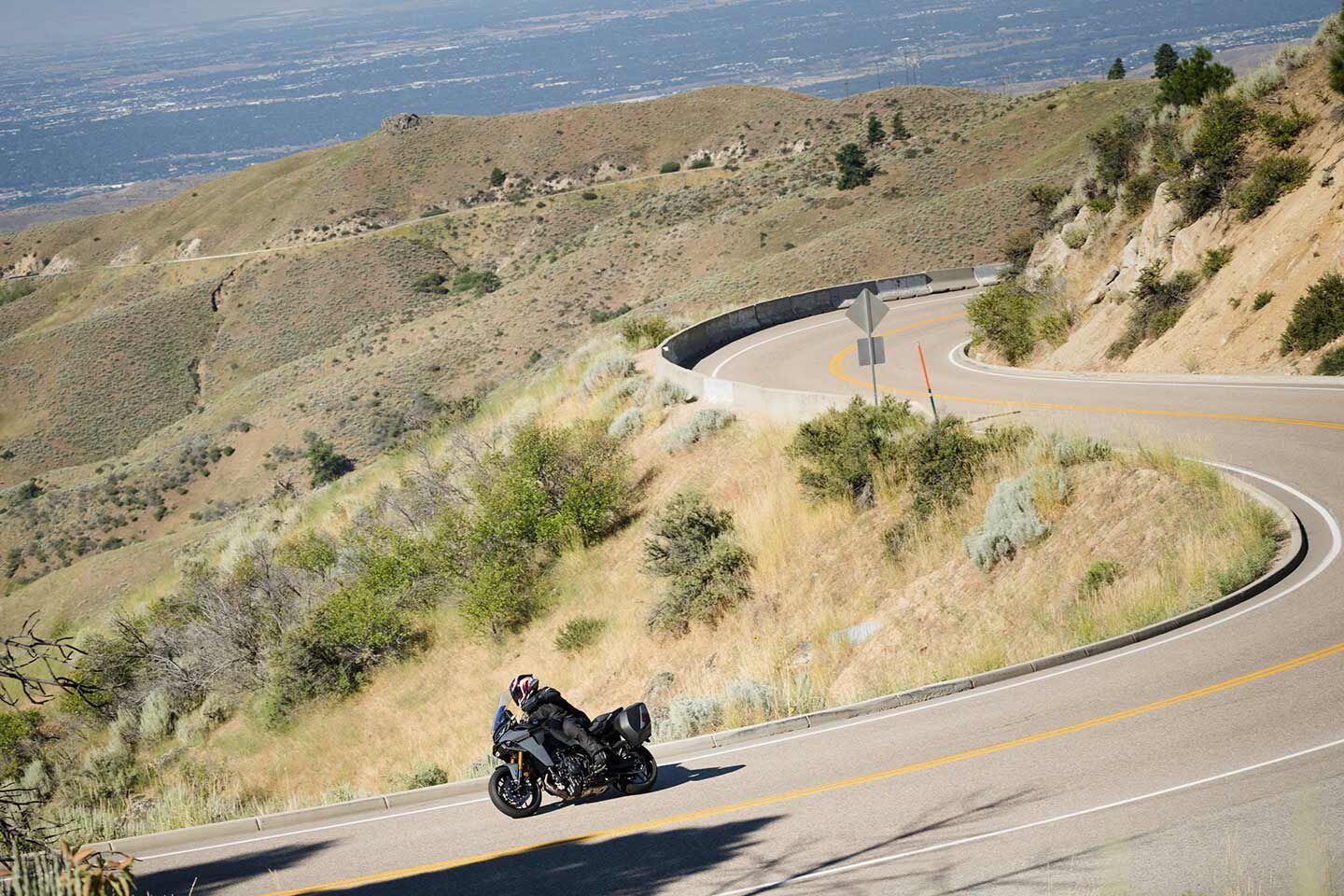 The Tracer 9 GT+ is in its element on a tight twisty road. (Joseph Agustin/)We also set up a Custom mode to get a sense of what the engine is like with TC and LIF turned off, and maybe see how the Tracer 9 GT+ is in the wheelie department. After confirming that it’s perfectly happy on the rear tire, we used Sport or Street for most of the day. The primary reason is that we wanted to try out the new Adaptive Cruise Control, and as mentioned TCS, SCS, and LIF must be active for the system to work. Handling is quite good, with a really sporty and agile turn-in and lots of composure delivered with the electronic suspension midcorner and over rough asphalt. Despite weighing just shy of 500 pounds, the Tracer carries that weight well, and in no way is ever heavy steering through transitions or into tight carousel hairpins. 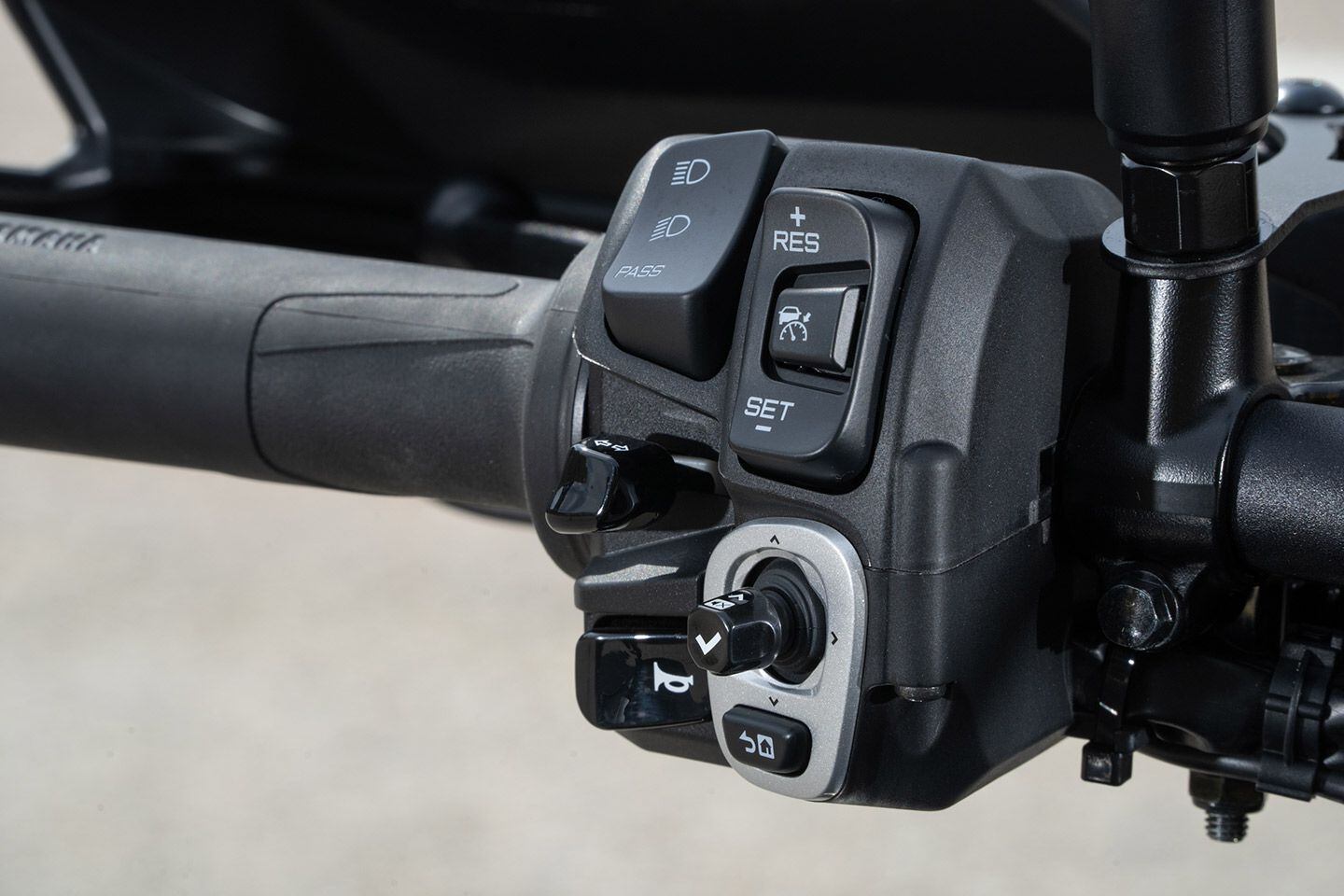 Yamaha’s new joystick and revised left-bar-mounted control pod greatly simplify menu navigation. (Joseph Agustin/)Perhaps one of the most obvious changes to the Tracer is the new 7-inch TFT display. This screen is excellent, offering lots of real estate for all the necessary information, but also allowing easy navigation with the new joystick to change settings. Perhaps a bit on the gimmicky side, one of the new display options turns the tach “needle” into a lightning show, with colored arcs following the needle’s path and changing colors. It’s kind of cool and different so we stuck with it. 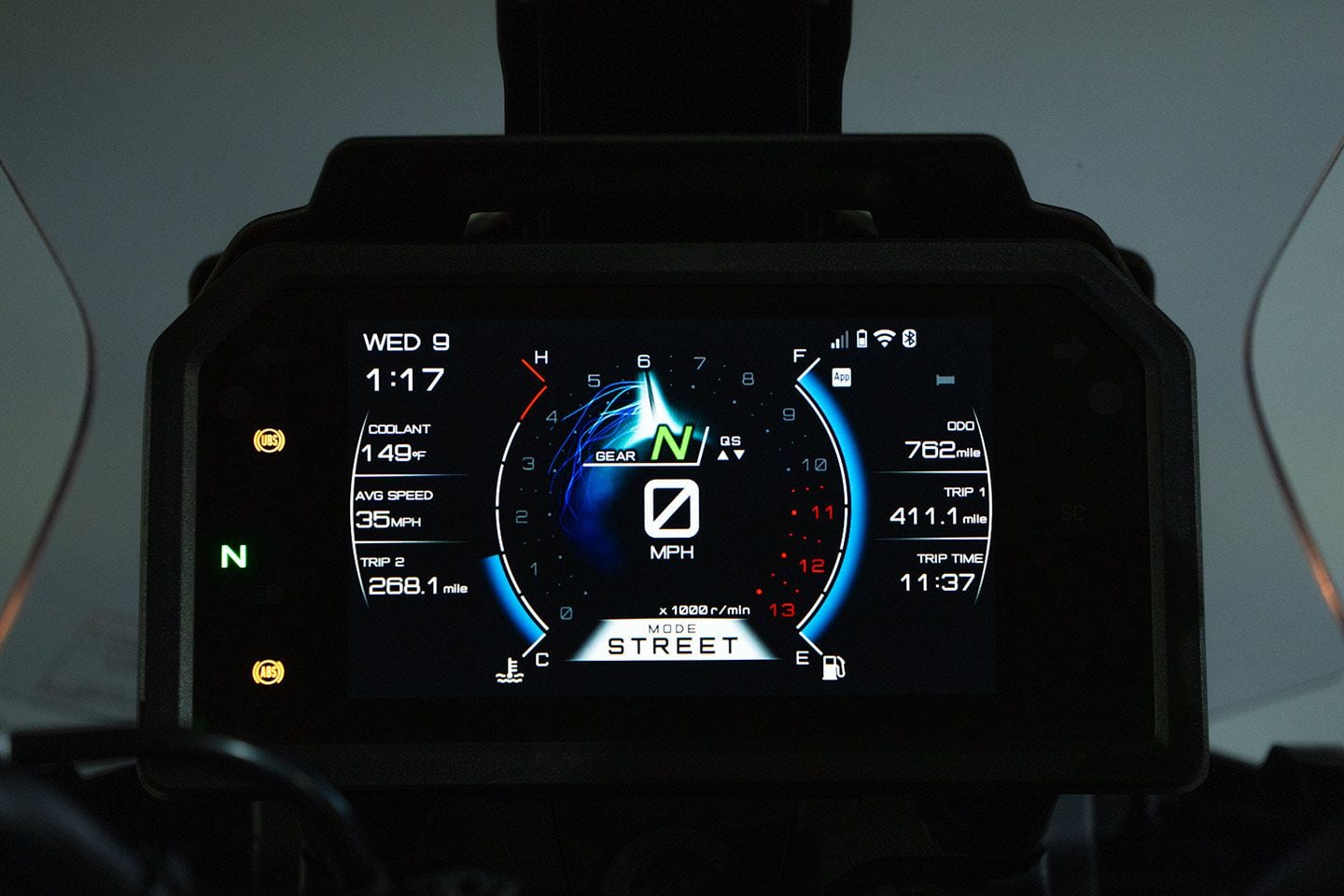 Maybe a bit on the kitschy side, but we thought this display option with the lightning bolts tach was fun. (Joseph Agustin/)Between our morning photo stops heading up to Bogus Basin and lunch, we hit some highway and were able to try out the cruise control. Activating, setting the speed, then setting the distance to the vehicle in front of you is very intuitive. Like the few other motorcycles that we recently tried with this feature, namely the much more expensive Ducati Multistrada and KTM 1290 Super Adventure, the Tracer 9 GT+’s system works really well in most situations. The only chink in its armor that we discovered was when riding in a group of motorcycles in a staggered formation, the radar wouldn’t always see the bike at an angle in front of you, and instead was picking up the bike another layer ahead directly in front of you. This would sometimes confuse the system and make it struggle to recognize when to start slowing down. Outside of that single scenario, it works great, and never failed to recognize a car or four-wheeled vehicle and maintain the distance. When you’re ready to pull out and pass, the system accelerates back up to your preset speed in a smooth manner without upsetting the chassis. Having just ridden across the country on a bike without this advanced type of cruise control we can say we wish we’d been on the Tracer. Just the fact that you don’t have to set and then disengage your setting every time you come up on another vehicle, and then reset it once you’ve made a pass, makes you wonder how you’ve ever lived with more rudimentary systems. 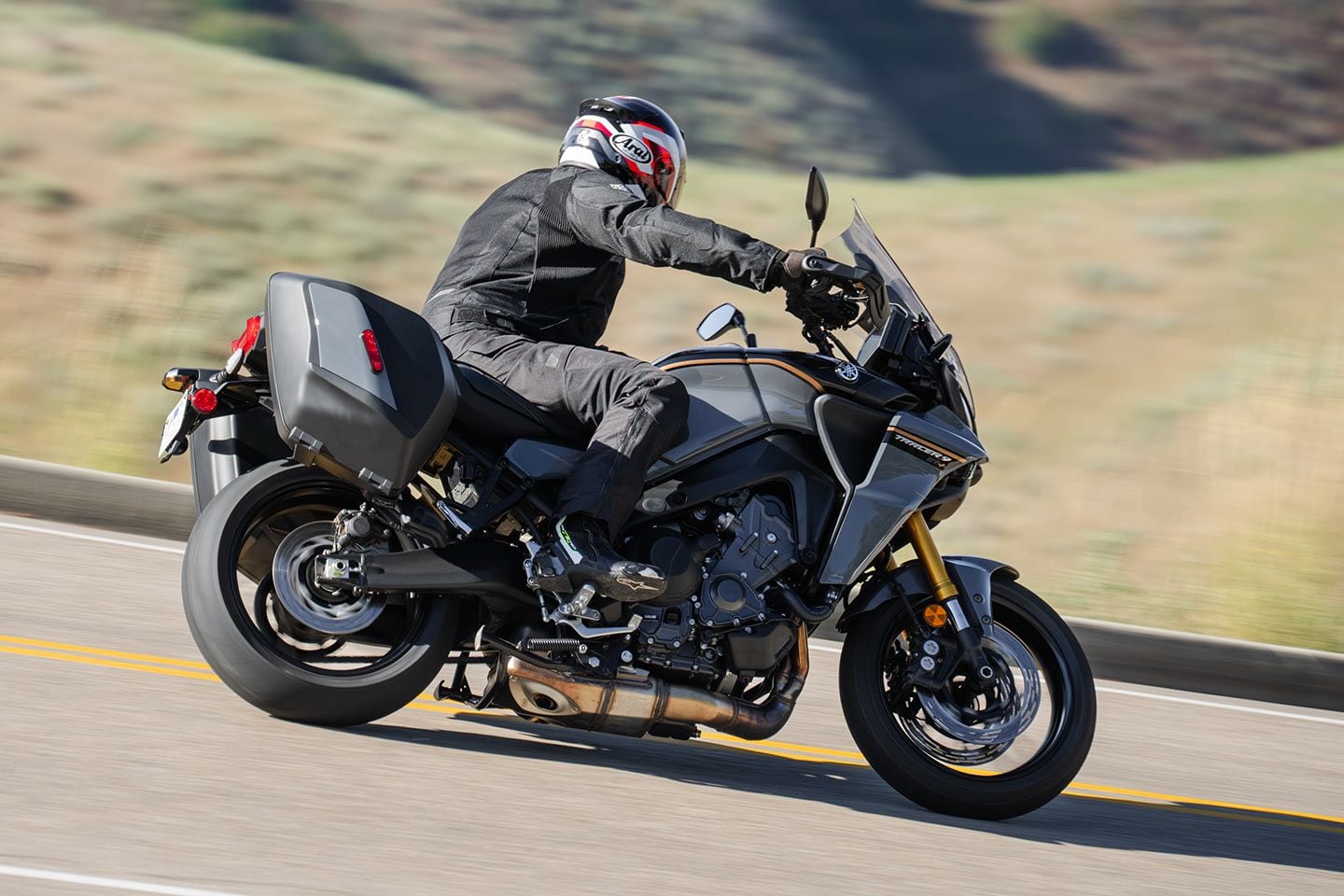 The Tracer 9 GT+ is just as happy on tight mountain roads as it is on the open highway, and that’s what a sport-touring model is all about. (Joseph Agustin/)If one was to ride across the country, the 9 GT+ would be an excellent choice. The ergonomics are sporty enough for spirited riding, but the rider triangle is relaxed and comfortable enough for long stints in the well-cushioned saddle. In the low seat setting, knees are just a bit past 90 degrees for this 5-foot-11 tester, but on a longer ride raising the seat to the high setting would give all-day comfort. Bar position is really good in the stock setting, with arms falling to a dead level plane, but as mentioned can be changed to preference. The tall touring windscreen allows a good clear view when riding in the tight twisties, and also provides a lot of wind protection and will definitely keep you in a nice bubble in the rain. The adjustable lever is easy to use in most circumstances, but at high speeds, wind pressure on the screen made it hard to move up and down. We never faced a situation where we detected the Unified Braking System in action. We either never were in a situation that triggered it, or in the situation where we did, its intervention was smooth and undetectable. We’ll test this further when we get a testbike back at HQ. Conclusion If the Tracer 9 GT+ is Yamaha’s vision of sport-touring for the foreseeable future, we like it. This bike is all about balance between power, weight, and features. By keeping the weight down, Yamaha is able to use the lightweight CP3 engine and provide solid engine performance. Overall, we think the triple is a great fit in this machine, providing a fun and torquey power delivery and yet is smooth and relaxed for long-distance rides. Compared to the big-bore offerings on the market, we really didn’t feel like the Tracer 9 GT+ is missing out in the engine department. 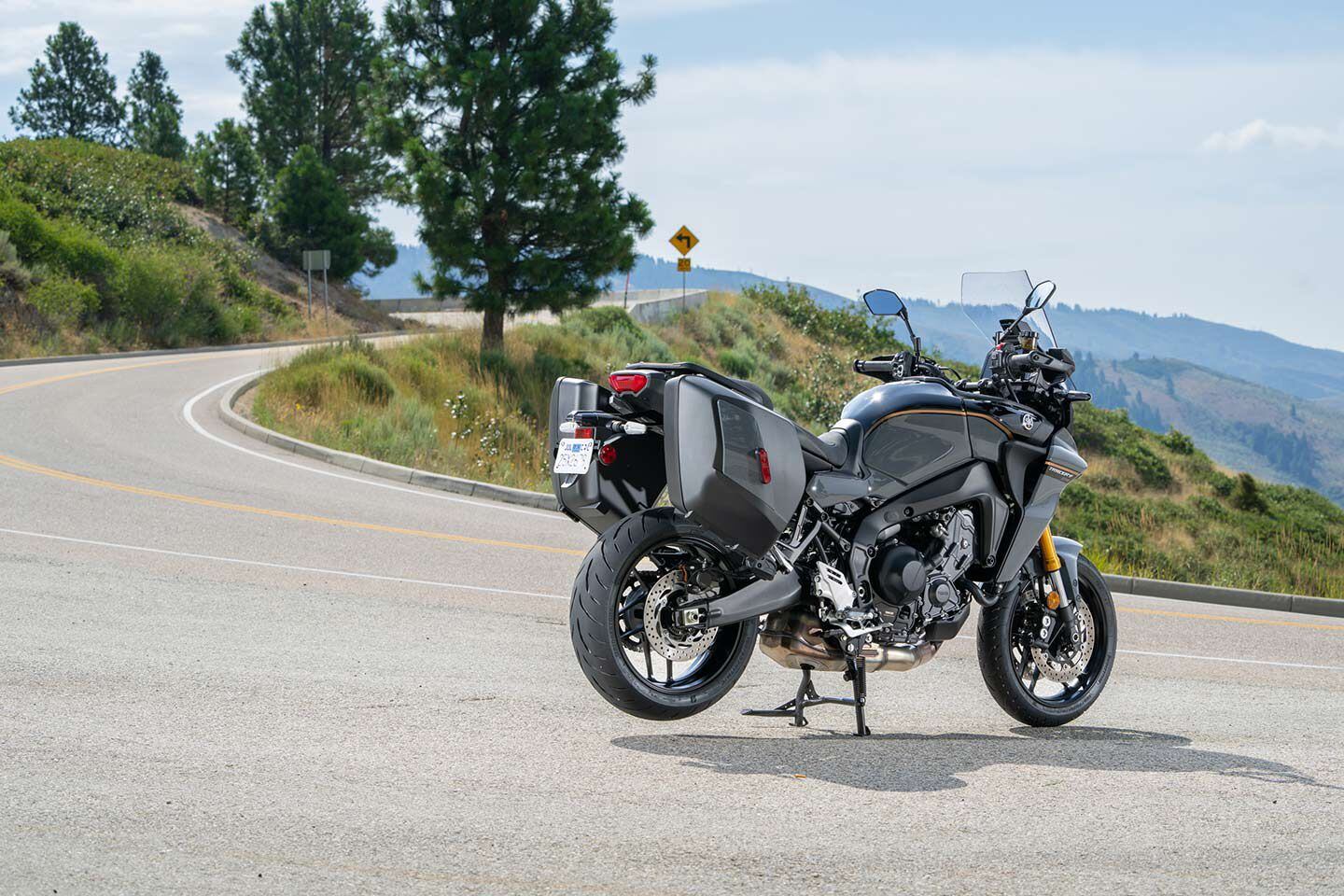 The Tracer 9 GT+ represents a good value as there aren’t too many other bikes—if any—in its price range with as strong of a technical package. (Joseph Agustin/)When it comes to electronics, there simply isn’t anything else in the middleweight class with this level of technology, let alone at such a reasonable price. Yamaha pulled a rabbit out of the hat when it included the two new radar-related features, electronic suspension, and top-notch rider-interface display and was still able to keep the price at $16,499. Most of the other bikes on the market with similar features are pushing $30,000. Sure, those models have open-class V-twins and V-4s, but those looking for all the technological bells and whistles who don’t want to spend a fortune or deal with larger, heavier bikes, the Yamaha Tracer 9 GT+ must be considered. Back to the point of a balanced package, the Tracer 9 GT+ has light and flickable handling which addresses the sport side of the equation, but the long list of touring amenities and adjustable ergonomics account for the touring side. Overall, there is very little to fault with the 9 GT+, just a few little things like the windscreen not being super easy to adjust on the fly, we’d love some improved mirrors that offer a better rearward view, and it would be nice to be able to get in and manually alter some of the damping settings. But that’s about it with the faults of the bike. If slaying miles and miles of twisty roads on the way to a far off destination is your goal, the Tracer 9 GT+ checks all the boxes. 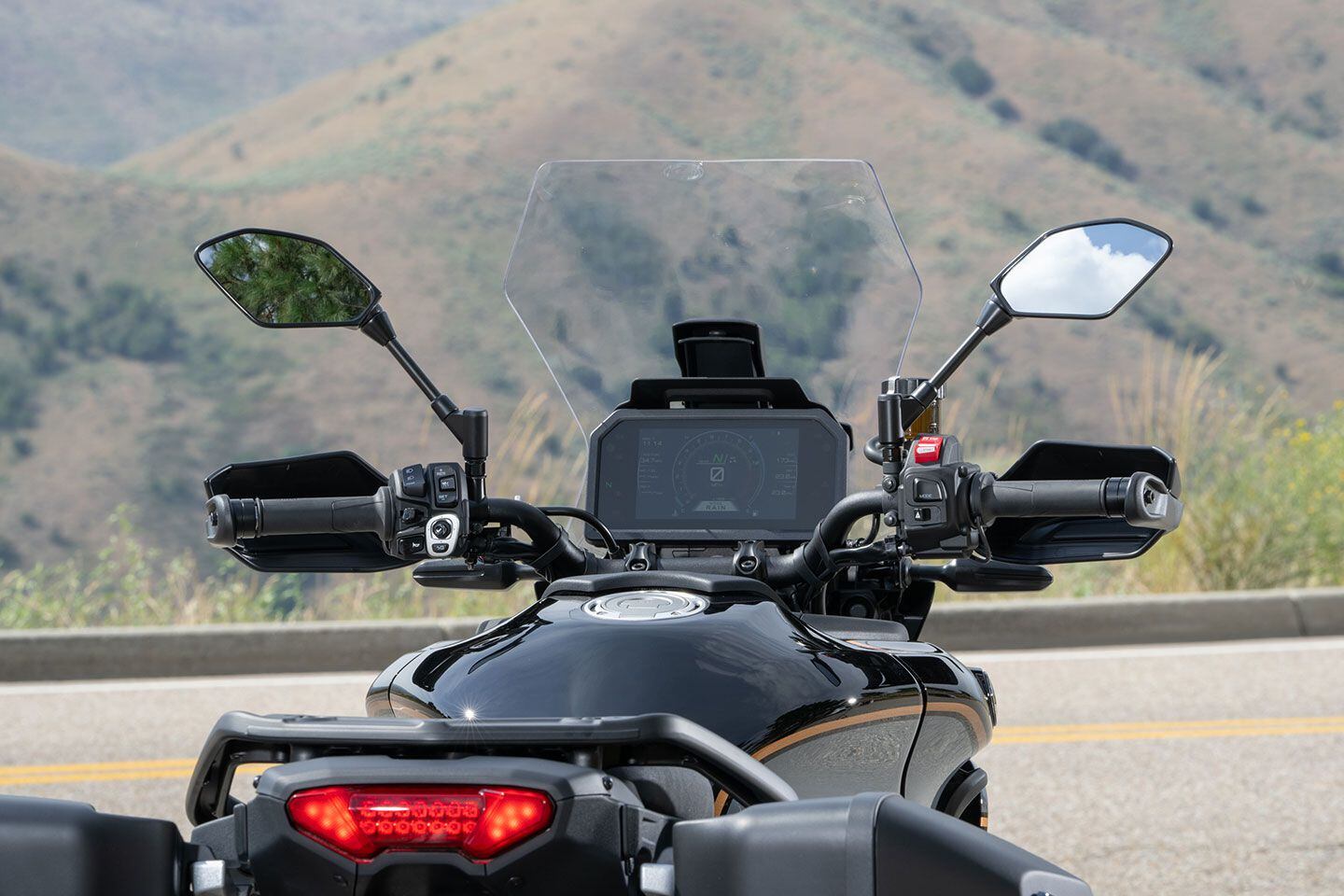 About the only thing we can fault in this cockpit are the mirrors, which could use slightly longer stalks. (Joseph Agustin/) 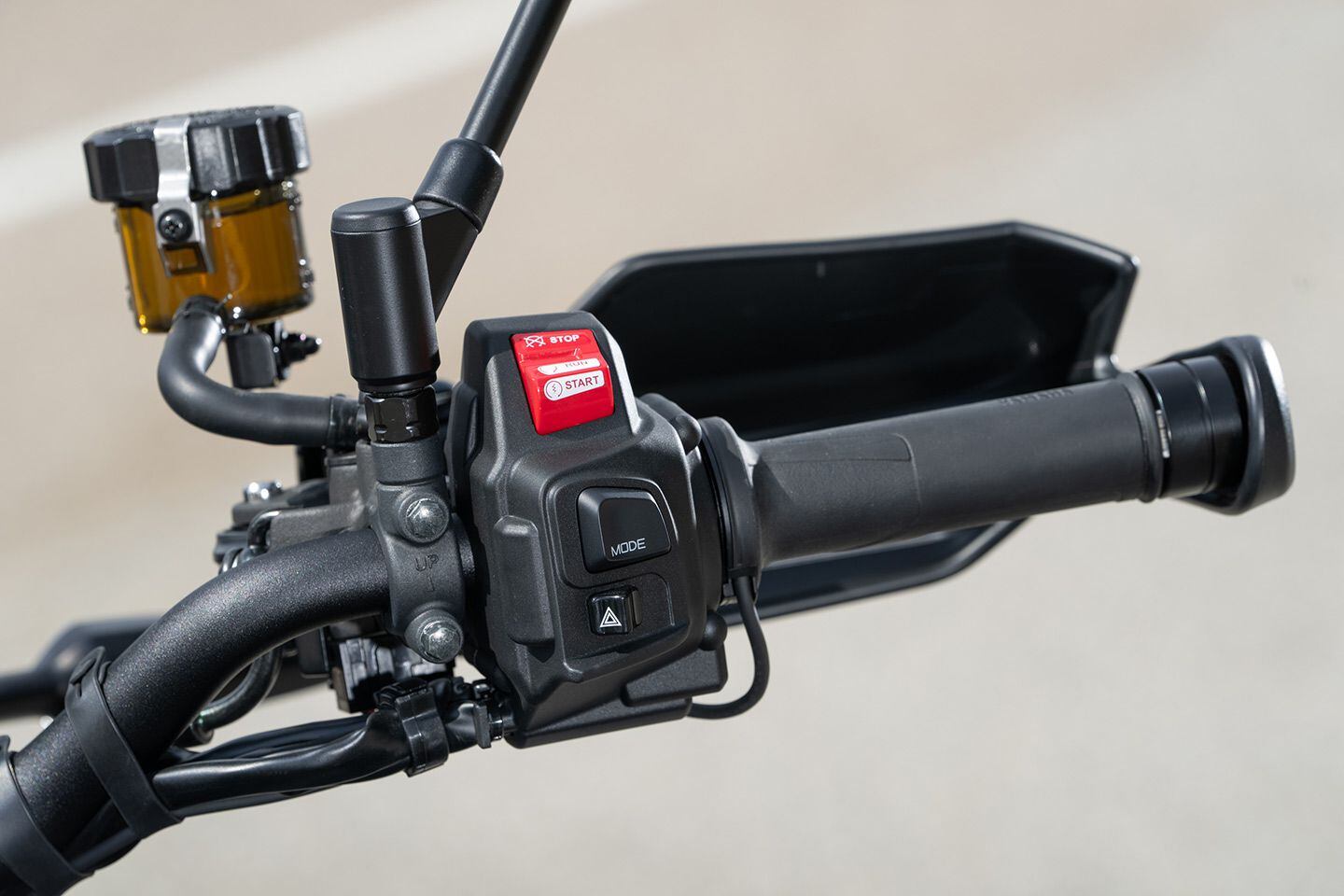 Mode changes can quickly be made on the fly from the right bar control pod. (Joseph Agustin/) 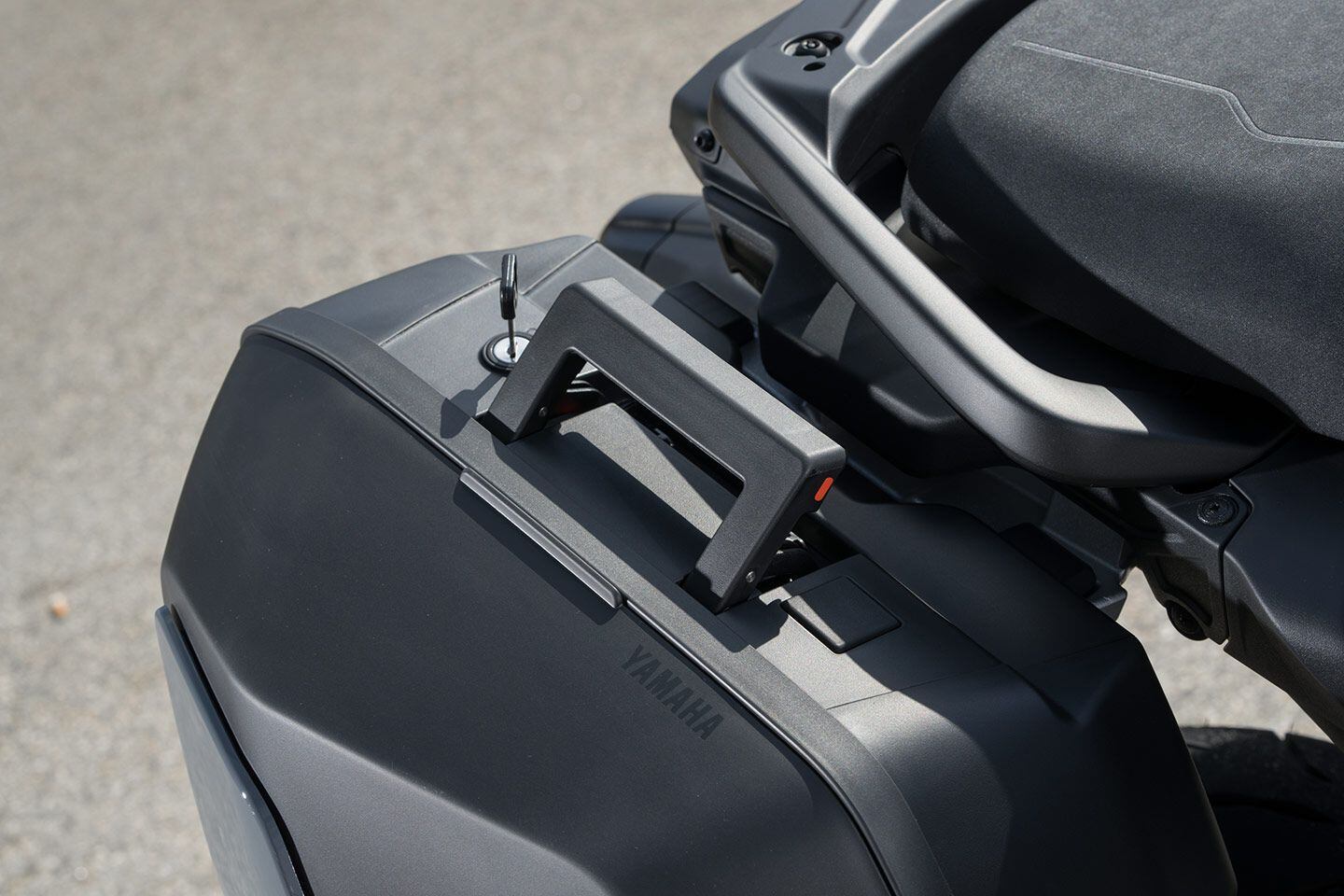 Lockable side cases use the same key as the ignition. (Joseph Agustin/) 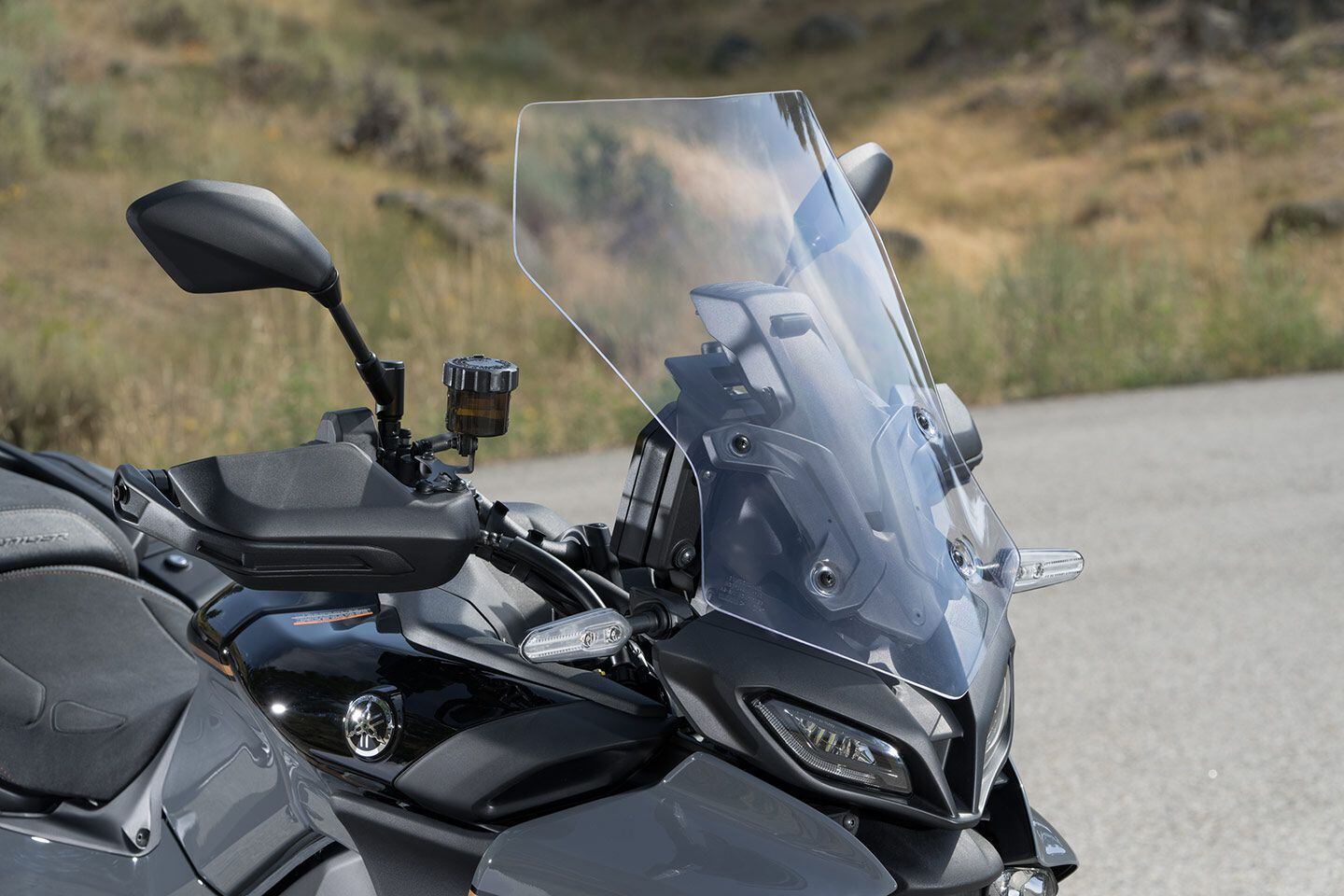 The windscreen can be adjusted with a lever above the dash on the fly. (Joseph Agustin/) 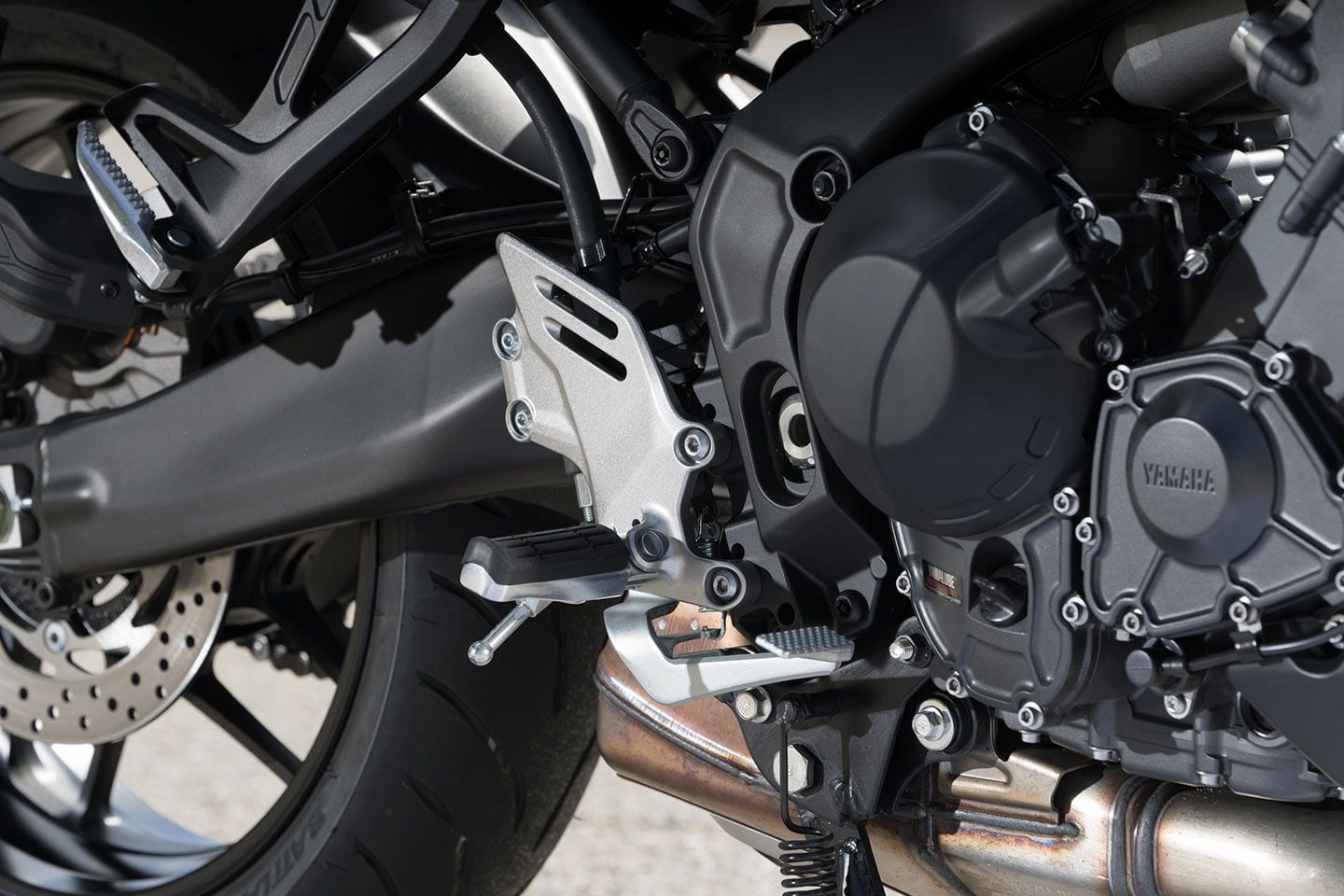 Adjustable footpegs allow two settings, a high and low position. (Joseph Agustin/)2024 Yamaha Tracer 9 GT+ Specs MSRP: $16,499 Engine: DOHC, liquid-cooled inline 3-cylinder; 4 valves/cyl. Displacement: 890cc Bore x Stroke: 78.0 x 62.1mm Compression Ratio: 11.5:1 Transmission/Final Drive: 6-speed/chain Fuel System: Fuel injection w/ YCC-T ride-by-wire Clutch: Wet, multiplate slipper/assist Engine Management/Ignition: TCI (Transistor Controlled Ignition) Frame: Cast aluminum Front Suspension: KYB 41mm fork, adjustable spring preload, electronically adjustable compression and rebound damping; 5.1 in. travel Rear Suspension: KYB shock, adjustable spring preload, electronically adjustable rebound damping; 5.4 in. travel Front Brake: Advics 4-piston calipers, dual 298mm discs w/ cornering ABS Rear Brake: 1-piston caliper, 267mm disc w/ ABS Tires, Front/Rear: Bridgestone Battlax Sport Touring T32; 120/70-17 / 180/55-17 Rake/Trail: 25.0°/4.3 in. Wheelbase: 59.1 in. Ground Clearance: 5.3 in. Seat Height: 32.3 in./32.9 in. Fuel Capacity: 5.0 gal. Claimed Wet Weight: 492 lb. Contact: yamahamotorsports.com GEARBOX 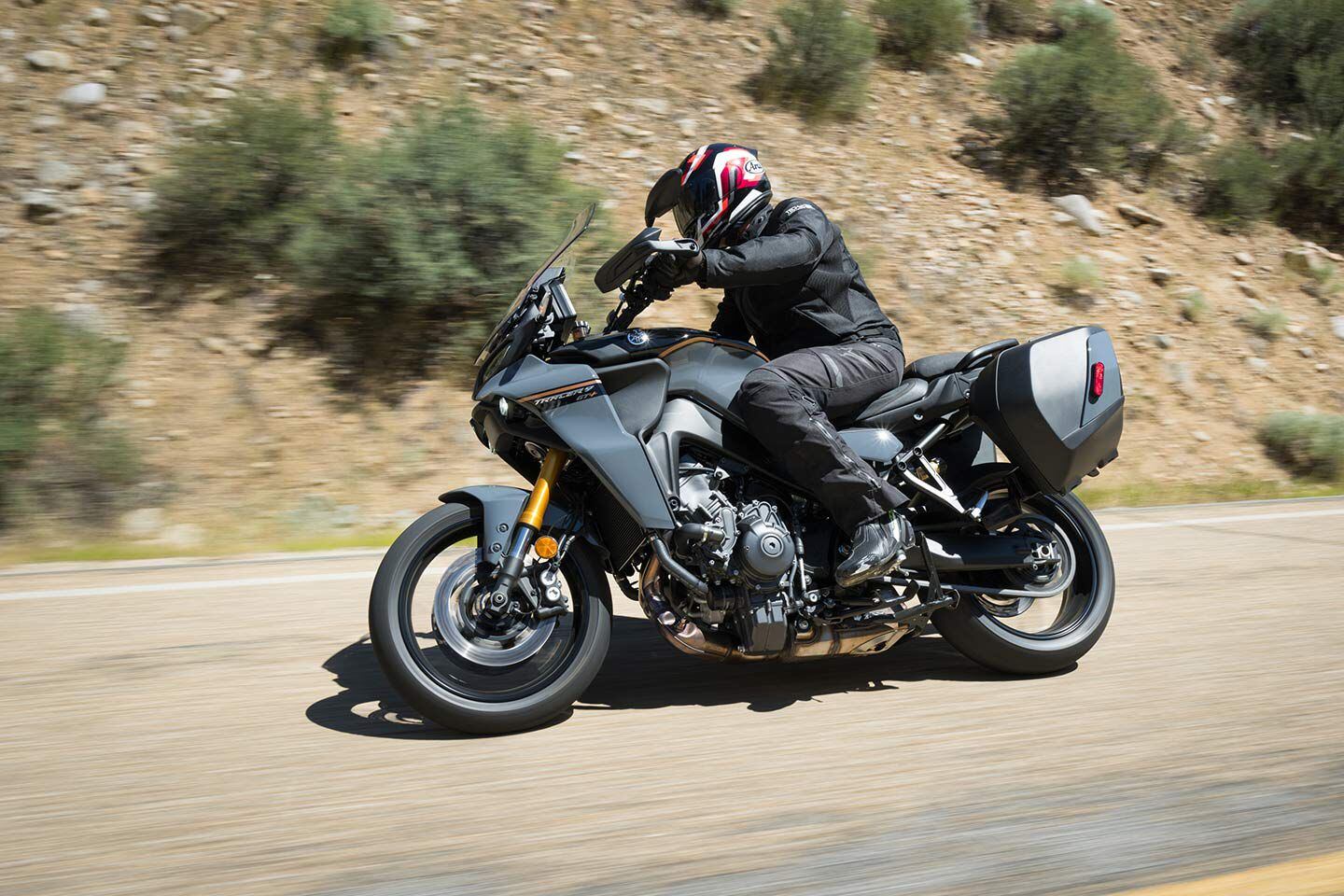 2024 Yamaha Tracer 9 GT+ (Joseph Agustin/)Helmet: Arai Contour-X Jacket: Alpinestars Tailwind Air Pant: Alpinestars Monteira Drystar XF Gloves: Alpinestars Halo Leather Boots: Alpinestars Supertech R Airbag: Alpinestars Tech-Air 5 System
__________________________________________________
I'm a bot. I don't need no stinkin' signature... |
|
|

|
 |
 Similar Threads
Similar Threads
|
||||
| Thread | Thread Starter | Forum | Replies | Last Post |
| [motorcyclistonline] - 2024 Yamaha Tracer 9 GT+ First Ride Review | Ninjette Newsbot | Motorcycling News | 0 | August 31st, 2023 10:29 AM |
| [RideApart] - 2024 Yamaha Tracer 9 GT+ First Ride Review | Ninjette Newsbot | Motorcycling News | 0 | August 16th, 2023 09:14 AM |
| [ridermagazine.com] - 2024 Yamaha Tracer 9 GT+ | First Look Review | Ninjette Newsbot | Motorcycling News | 0 | July 26th, 2023 04:26 PM |
| [cycleworld.com] - 2024 Yamaha Tracer 9 GT+ First Look | Ninjette Newsbot | Motorcycling News | 0 | July 26th, 2023 04:03 PM |
| [motorcycle.com] - Yamaha Tracer 9 GT+ Finally Coming to US for 2024 | Ninjette Newsbot | Motorcycling News | 0 | April 6th, 2023 04:22 PM |
|
|